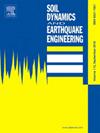通过大尺度三维数值模型研究浅埋水层的地震行为
IF 4.2
2区 工程技术
Q1 ENGINEERING, GEOLOGICAL
引用次数: 0
摘要
随着地下水库越来越多地被用于储水和输水,它们现在被视为地震时必须继续运行的关键基础设施。本文介绍了一项大规模数值参数研究的结果,该研究旨在加深我们对地下水库地震流体-结构-土壤相互作用(FSSI)响应的理解。研究采用了先进的非线性三维 FSSI 数值模型,同时考虑了水库规模、埋深、土壤剖面和地动变化。研究表明,与其他常规地下结构不同,地面峰值加速度(PGA)与水库地震响应的相关性最强。研究发现,增加埋设深度或水库规模通常会增加对结构元件的要求,同时减少基底和回填土的滑动。研究发现,较松软的场地会导致顶架增加,包括运动的垂直分量也会增加水动压力。在柱子中,最靠近中心的柱子承受的压力最大,而位于角落的柱子承受的压力最小。事实上,在一些极端情况下,由于缺乏结构冗余,蓄水池的完全坍塌是由支柱失效引起的。观察到屋顶平面剪应力在墙壁附近累积,表明存在隔墙行为。与其他地下结构相比,该水库的地震响应非常独特,因此无法采用常用的简化设计程序。相反,三维 FSSI 数值模型被证明是地下水库抗震设计的可靠工具。本文章由计算机程序翻译,如有差异,请以英文原文为准。
Seismic behavior of shallow buried water reservoirs via large scale three-dimensional numerical models
As buried water reservoirs are increasingly being utilized to store and deliver water, they are now regarded as critical infrastructures that must continue to operate in the event of an earthquake. This paper presents the results of a large-scale numerical parametric study that was carried out to advance our understanding of the seismic fluid-structure-soil interaction (FSSI) response of buried water reservoirs. Advanced nonlinear three-dimensional (3D) FSSI numerical models of reservoirs were employed while considering reservoir size, embedment depth, soil profile, and ground motion variability. The study showed that, unlike other conventional underground structures, the peak ground acceleration (PGA) has the strongest correlation to the reservoir seismic response. Increasing the embedment depth or reservoir size was found to generally increase the demands on the structural elements while reducing the base and backfill slippage. Softer sites were found to cause an increase in the roof racking and including the vertical component of the motion increased the water dynamic pressures. Among the columns, the ones closest to the center were found to experience the highest demands and the ones at the corner the lowest. In fact, in some extreme cases, a total collapse of the reservoir was initiated by column failure due to the lack of structural redundancy. The roof in-plane shear stresses were observed to accumulate near the walls, indicating a diaphragm behavior. The reservoir's unique seismic response compared to other underground structures makes generalizing the commonly used simplified design procedures inapplicable. Instead, 3D FSSI numerical models were demonstrated to be a reliable tool for the seismic design of buried reservoirs.
求助全文
通过发布文献求助,成功后即可免费获取论文全文。
去求助
来源期刊

Soil Dynamics and Earthquake Engineering
工程技术-地球科学综合
CiteScore
7.50
自引率
15.00%
发文量
446
审稿时长
8 months
期刊介绍:
The journal aims to encourage and enhance the role of mechanics and other disciplines as they relate to earthquake engineering by providing opportunities for the publication of the work of applied mathematicians, engineers and other applied scientists involved in solving problems closely related to the field of earthquake engineering and geotechnical earthquake engineering.
Emphasis is placed on new concepts and techniques, but case histories will also be published if they enhance the presentation and understanding of new technical concepts.
 求助内容:
求助内容: 应助结果提醒方式:
应助结果提醒方式:


